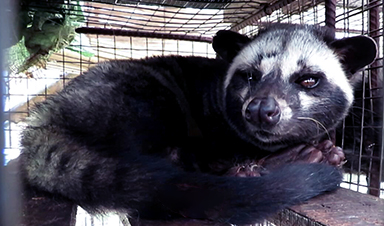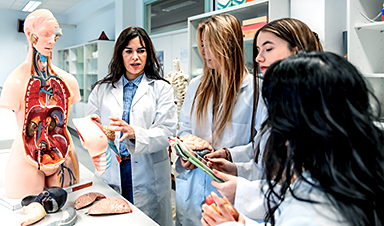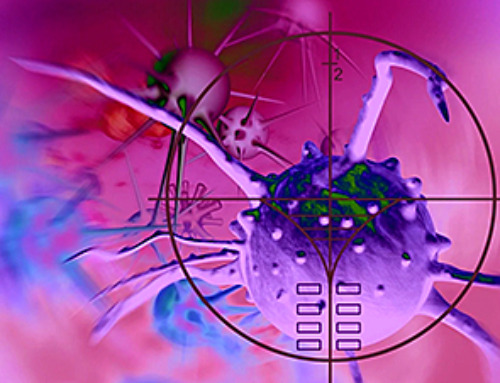Although first detected in December 2019, COVID-19 was inferred to be present in Hubei province, China, for about a month before. Where did this new human disease come from? To understand the origin of the COVID-19 pandemic, it is necessary to go back to 2002. At that time a novel respiratory coronavirus appeared in Foshan, Guangdong province, China, and spread to 29 countries. Altogether ~8000 people were infected with severe acute respiratory syndrome coronavirus (SARS-CoV) before public health measures controlled its spread in 2003. The zoonotic origin of SARS-CoV was subsequently linked to live animals available at markets. Further sporadic spillover events of SARS-CoV from animals took place in Guangzhou, Guangdong, and some researchers working with cultured virus were infected in laboratory accidents, but ultimately SARS-CoV was removed from the human population. Trading of susceptible host animals is an important common theme in the origins of SARS and COVID-19.
Three years after the SARS epidemic began, investigations revealed that horseshoe bats (Rhinolophus) in China were harboring related coronaviruses. These collectively form the species SARS-related coronavirus (SARSr-CoV), which comprises the Sarbecovirus subgenus of the Betacoronavirus genus. It was inferred that a sarbecovirus circulating in horseshoe bats seeded the progenitor of SARS-CoV in an intermediate animal host, most probably civet cats. Although other possible intermediate hosts for SARS-CoV were identified, in particular raccoon dogs and badgers (for sale with civet cats in animal markets), it is a population of civet cats within markets that appear to have acted as the conduits of transmission to humans from the horseshoe bat reservoir of SARS-CoV, rather than civet cats being a long-term reservoir host species. Presumably a captive civet cat initially became infected by direct contact with bats—e.g., as a result of bats foraging in farms or markets—or was infected prior to capture. Following the SARS epidemic, further surveillance revealed the immediate threat posed by sarbecoviruses from horseshoe bats. Despite this clear warning, another member of the SARSr-CoV species, SARS-CoV-2, emerged in 2019 that spread with unprecedented efficiency among humans. There has been speculation that the Wuhan Institute of Virology (WIV) in Hubei was the source of the pandemic because no SARS-CoV-2 intermediate host has been identified to date and owing to the WIV’s geographic location.
SARS-CoV-2 first emerged in Wuhan city, which is >1500 km from the closest known naturally occurring sarbecovirus collected from horseshoe bats in Yunnan province, leading to an apparent puzzle: How did SARS-CoV-2 arrive in Wuhan? Since its emergence, sampling has revealed that coronaviruses genetically close to SARS-CoV-2 are circulating in horseshoe bats, which are dispersed widely from East to West China, and in Southeast Asia and Japan. The wide geographic ranges of the potential reservoir hosts—for example, intermediate (R. affinis) or least (R. pusillus) horseshoe bat species, which are known to be infected with sarbecoviruses—indicate that the singular focus on Yunnan is misplaced. Confirming this assertion, the evolutionarily closest bat sarbecoviruses are estimated to share a common ancestor with SARS-CoV-2 at least 40 years ago, showing that these Yunnan-collected viruses are highly divergent from the SARS-CoV-2 progenitor. The first of these viruses reported by WIV, RaTG13, is certainly too divergent to be the SARS-CoV-2 progenitor, providing key genetic evidence that weakens the “lab-leak” notion. Additionally, three other sarbecoviruses collected in Yunnan independently of WIV are now the closest bat coronaviruses to SARS-CoV-2 that have been identified: RmYN02, RpYN06, and PrC31 (see the figure).
So, how did SARS-CoV-2 get into humans? Although it is possible that a virus spillover occurred through direct horseshoe bat–to–human contact, a known risk for SARSr-CoVs, the first detected SARS-CoV-2 cases in December 2019 are associated with Wuhan wet markets. This is consistent with multiple animal-market–associated spillover events in November and December. It is currently not possible to be certain of the animal source of SARS-CoV-2, but it is notable that live animals, including civet cats, foxes, minks, and raccoon dogs, all susceptible to sarbecoviruses, were for sale in Wuhan markets, including the Huanan market (identified as an epicenter of the outbreak in Wuhan) throughout 2019. Many of these animals are farmed for their fur at large scale and then sold to animal markets. Some of these farmed species (American minks, red foxes, and raccoon dogs) were sold alive for food by Wuhan animal sellers, as was trapped wildlife (including raccoon dogs and badgers), although no bat species were for sale. Together, this suggests a central role for SARSr-CoV–susceptible live intermediate host animals as the primary source of the SARS-CoV-2 progenitor that humans were exposed to, as was the case with the origin of SARS.
If these routes of transmission to humans are in place, why is emergence so rare that only two major outbreaks have occurred in the last two decades? Spillover events are not so unusual in locations where more frequent human-animal contacts take place. This is indicated by serology studies showing evidence for SARSr-CoV–specific antibodies in people living in rural locations, and even higher rates recorded in people living near bat caves. Spillover risk will increase with human encroachment into rural areas, resulting from new travel networks around and between urban areas. When a novel virus is then exposed to a densely packed human population, such as in Wuhan city, these spillover events have a much higher chance of resulting in substantial onward spread.
News
Most Plastic in the Ocean Is Invisible—And Deadly
Nanoplastics—particles smaller than a human hair—can pass through cell walls and enter the food web. New research suggest 27 million metric tons of nanoplastics are spread across just the top layer of the North [...]
Repurposed drugs could calm the immune system’s response to nanomedicine
An international study led by researchers at the University of Colorado Anschutz Medical Campus has identified a promising strategy to enhance the safety of nanomedicines, advanced therapies often used in cancer and vaccine treatments, [...]
Nano-Enhanced Hydrogel Strategies for Cartilage Repair
A recent article in Engineering describes the development of a protein-based nanocomposite hydrogel designed to deliver two therapeutic agents—dexamethasone (Dex) and kartogenin (KGN)—to support cartilage repair. The hydrogel is engineered to modulate immune responses and promote [...]
New Cancer Drug Blocks Tumors Without Debilitating Side Effects
A new drug targets RAS-PI3Kα pathways without harmful side effects. It was developed using high-performance computing and AI. A new cancer drug candidate, developed through a collaboration between Lawrence Livermore National Laboratory (LLNL), BridgeBio Oncology [...]
Scientists Are Pretty Close to Replicating the First Thing That Ever Lived
For 400 million years, a leading hypothesis claims, Earth was an “RNA World,” meaning that life must’ve first replicated from RNA before the arrival of proteins and DNA. Unfortunately, scientists have failed to find [...]
Why ‘Peniaphobia’ Is Exploding Among Young People (And Why We Should Be Concerned)
An insidious illness is taking hold among a growing proportion of young people. Little known to the general public, peniaphobia—the fear of becoming poor—is gaining ground among teens and young adults. Discover the causes [...]
Team finds flawed data in recent study relevant to coronavirus antiviral development
The COVID pandemic illustrated how urgently we need antiviral medications capable of treating coronavirus infections. To aid this effort, researchers quickly homed in on part of SARS-CoV-2's molecular structure known as the NiRAN domain—an [...]
Drug-Coated Neural Implants Reduce Immune Rejection
Summary: A new study shows that coating neural prosthetic implants with the anti-inflammatory drug dexamethasone helps reduce the body’s immune response and scar tissue formation. This strategy enhances the long-term performance and stability of electrodes [...]
Scientists discover cancer-fighting bacteria that ‘soak up’ forever chemicals in the body
A family of healthy bacteria may help 'soak up' toxic forever chemicals in the body, warding off their cancerous effects. Forever chemicals, also known as PFAS (per- and polyfluoroalkyl substances), are toxic chemicals that [...]
Johns Hopkins Researchers Uncover a New Way To Kill Cancer Cells
A new study reveals that blocking ribosomal RNA production rewires cancer cell behavior and could help treat genetically unstable tumors. Researchers at the Johns Hopkins Kimmel Cancer Center and the Department of Radiation Oncology and Molecular [...]
AI matches doctors in mapping lung tumors for radiation therapy
In radiation therapy, precision can save lives. Oncologists must carefully map the size and location of a tumor before delivering high-dose radiation to destroy cancer cells while sparing healthy tissue. But this process, called [...]
Scientists Finally “See” Key Protein That Controls Inflammation
Researchers used advanced microscopy to uncover important protein structures. For the first time, two important protein structures in the human body are being visualized, thanks in part to cutting-edge technology at the University of [...]
AI tool detects 9 types of dementia from a single brain scan
Mayo Clinic researchers have developed a new artificial intelligence (AI) tool that helps clinicians identify brain activity patterns linked to nine types of dementia, including Alzheimer's disease, using a single, widely available scan—a transformative [...]
Is plastic packaging putting more than just food on your plate?
New research reveals that common food packaging and utensils can shed microscopic plastics into our food, prompting urgent calls for stricter testing and updated regulations to protect public health. Beyond microplastics: The analysis intentionally [...]
Aging Spreads Through the Bloodstream
Summary: New research reveals that aging isn’t just a local cellular process—it can spread throughout the body via the bloodstream. A redox-sensitive protein called ReHMGB1, secreted by senescent cells, was found to trigger aging features [...]
AI and nanomedicine find rare biomarkers for prostrate cancer and atherosclerosis
Imagine a stadium packed with 75,000 fans, all wearing green and white jerseys—except one person in a solid green shirt. Finding that person would be tough. That's how hard it is for scientists to [...]





















